A (Very) Brief History of the Imperial Marque
(This will be very brief. There are other places that already have this information, and links to those places can be found at 'Other Places To Find Out About Imperials' on this site.)
Once upon a time, in a century long, long ago, there was a company called the Chrysler Corporation. It was named after Walter P. Chrysler in 1924, but had existed prior to that as the Maxwell Corporation. Walter P. took over the floundering company after a series of stints at a variety of different companies. He began in the locomotive construction business, and then worked briefly for Buick and, immediately prior to Maxwell, the Willys-Overland Company, which he successfully turned around from the brink of disaster. He was not a designer. He was a very competent engineer and an administrator of uncommon talents. A lover of cars, he was able to put together strategies and teams of people to build and sell vehicles with above average engineering, innovation and content, and make money doing so. Many another company leader might have had some of those qualities, but Chrysler had them all.

1928 Imperial
Click on image to enlarge
Imperials were launched in 1926, only two years after the first Chrysler cars, from this company, were introduced. They were the very top of the line models of Chrysler, but were not a separate model. Chryslers were solidly middle class cars and the Imperial was an attempt to take them up market without having to have an entirely different line, which would involve a whole series of costs, and maybe even an independent distribution line as well. As well as having an Imperial model of its regular cars, the name was also put onto custom models and limousines.
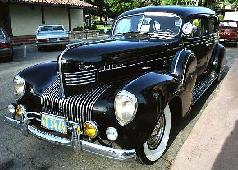
1939 Imperial C24 Limousine
Click on image to enlarge
So it all becomes a little confusing and leads to a very common problem. Are the cars Chrysler Imperials, or simply Imperials? The answer is 'both.' Because, in 1955, Imperials became a separate model entirely and no longer a Chrysler Imperial. But . . . and this is where the fun begins, they were still an upgraded version of the regular Chrysler model, in this case Virgil Exner's fabulous "Million Dollar" look cars. The cars had some nice features to distinguish them from regular Chryslers, in particular the rear lights, which were mounted in a free standing assembly on top of the fenders, instead of on the rear itself, and are exquisite vehicles.
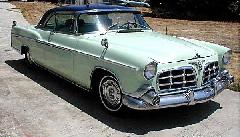
1956 Imperial Coupe
Click on image to enlarge
Unlike Toyota and Nissan, so many years later with their Lexus and Infiniti lines, Chrysler did not create an Independent distribution chain. You bought your Imperial from a regular Chrysler dealership, which usually also sold Plymouths. The cars sold well, but the car buying public was confused. The two lines were advertised separately.
Some of that confusion was removed in 1957. Chrysler introduced a whole new line of cars, the breath taking 'Forward Look" line, which many consider to be Virgil Exner's masterpiece. And, Imperial was give an entirely different body of it's own, for the first time. In addition, the advertising tag line was "Finest Expression of the Forward Look," which neatly encapsulated their position as the premier model, while still maintaining their connection to the whole line up. The Chrysler Corporation logo was introduced to reflect it's five "brands" - Chrysler, DeSoto, Dodge, Imperial and Plymouth.
Not only did Imperial get its own body style. It also had its own chassis. In fact, despite being built at the same Jefferson Avenue plant as regular Chrysler vehicles, the new Imperial line had a virtually unique component set, an amazing investment in a line that was never intended to be a huge seller. The "Forward Look" designs were breath takingly new and were a hit straight out of the box for all the Corporation's models. None more so than Imperial, which actually outsold Lincolns for one of the few times in its history in 1957.
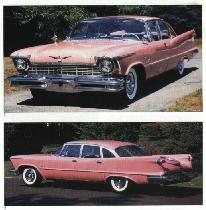
1957 Imperial
Click on image to enlarge
But, as is so often the case in the history of Chrysler Corporation, this very success was the seed of a downfall. That downfall was quality. The design was brilliant, but as production was ramped up across the board to meet demand, build quality plummeted. Parts were out sourced to manufacturer's, who had little time to achieve high quality processes, and the cars were slap dashed together, virtually. In addition rust prevention was all but ignored, and a recipe for disaster was brewing. Initial sales were magnificent, for all of the Corporation's models, but began to slump badly as the cars' reputation rapidly deteriorated.
By 1958, by which time many of the production woes had been addressed, sales began to tumble badly, falling 31% from the previous year's all time high. There was also a mini recession that year and some major strikes, but the damage to the cars was done. In car buyers minds the cars were rust heaps, and it would take many years for Imperials and the whole company's products to overcome that impression.
As already mentioned, the cars were always intended to be a limited production model. As such, with falling sales, it was very hard to justify an all new car, and so the underpinnings of the cars remained almost unchanged until 1968, when unibody construction replaced the old body on frame chassis of previous years.
Elwood Engel, ironically the designer of the very poorly received 1958 Lincoln, (see the Comparison page on this site), replaced Virgil Exner as head of design in the early 60's and he was largely responsible for an an new looking Imperial for 1964. The cars had substantial changes after 1959, even to the point of losing their fins, but the 1964 was a whole new look for Imperials
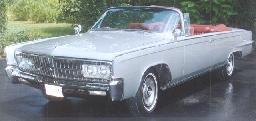
1965 Imperial
Click on image to enlarge
Sales jumped with the introduction of the all new models. Once again, the corporation's fortunes were on the upswing and its cars a reflections of the times. The '60's were a time of change and youth culture dominated the landscape, and the cars of the time reflected that. The were straighter and less adorned than before. The body style contined into 1968, but there were significant appearance and equipment changes each year to keep the car's fresh. In 1967 there was a big change under the similar looking skin: unibody construction was introduced. Among collectors the '67's and '68's are some of the most popular. Their wheelbase was 127 inches, three inches greater than the regular Chryslers of the day, although both had similar construction, called the 'C' body in Mopar speak.
Even at this point, despite the success of the line, there still was not a separate distribution chain for Imperials. Also, as development costs for cars grew, with greater governmental involvement and the emphasis on safety, and envoirenmental regulations, justifying the expense of developing a separate line of cars became harder and harder for a perrenially cash strapped organization to do. Imperials began to share more and more common components with others cars being built by the company.
A brand new design theme was intoduced in 1969. The new cars were given the name "fuselage." The cars were bigger and rounder than ever before, and their bulk was, to start with, quite in tune with the times. Then came the energy crisis of 1973, and all of a sudden the big barges being built by the Big Three became, almost overnight, leviathans, gas guzzlers, hopelessly impractical in a time of shortage.
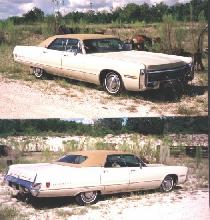
1973 Imperial
Click on image to enlarge
And, in 1975, it all came to an end. The Corporation, faced with falling sales, and other pressure from all sides, pulled the plug unceremoniously in mid 1975 and that was that, the end of the line, just one year short of its fiftieth anniversary.
IMPERIAL
R.I.P. 1926 - 1975
THEN . . . Like a phoenix, rising from the ashes . . . the name came back! The company, under the new leadership of a former Ford executive who shall remain nameless, Lee Iococca, decided to introduce a "Personal Luxury Vehicle," along the lines of the Thunderbird.

1981 Imperial
Click on image to enlarge
Unlike former Imperials, which had coupes, sedans, convertibles four door hardtops, this was was only to come as a coupe. Based on the Chrysler Cordoba / Dodge Mirada platform, but sharing little sheet metal except the doors and the front bumper, this car, introduced as it was at the Corporations darkest hour, was a way for the company to recreate an image of confidence and style to the buying piblic. It had, as was always the case for Imperials, some ground breaking innovations. Not the least of these was an early attempt at fuel injection. The car had a 318 V8 engine, as did many cars in the Mopar line, but the fuel injection syestem was to differentiate the car from its siblings and show the company was still capable of leading edge technology.
And, where better to introduce than a car that would never really go beyond limited production? In its first year the model sold almost 8000 units, but the car was a little out of time and of a type not normally associated with Mopar, and sales the following year fell drastically. Production ended in 1983, so the run only lasted just three short years. Another not so sweet end to a proud line. . .
THEN . . . Like a phoenix, rising from the ashes . . . the name came back . . . AGAIN !
The name was resurrected one last time, in 1991. As it was in the very beginning, in 1926, it was launced as a top of the line version of the regular Chrysler product of the day. The comapny had been very successfully turned around, the K cars had been a big hit with the public, the minivan was doing gangbuster business . . . basically things were looking good for the company.
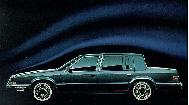
1992 Imperial
Click on image to enlarge
But not really for Imperial. The cars were a pale shadow of their once glorious past. No big old V8 under the hood, nothing 'special' to set them apart from the regular Chrysler. As more and more luxury appointments became standard features in every day cars, the popularity of a "luxury" car that did not stand out that much was not great. They were and are very nice cars, but just not what Imperials used to be. After four years, the name again, sank into oblivion. With the introduction of new models, like the Concorde, and the Neon, the application of the Town & Country moniker to the plushest minivan, it is hard to believe we shall ever see a new Imperial again. Another nail in the name's coffin would appear to be the take over of the comapny by the German Daimler Benz company. Why would they introduce yet another rival to their own Mercedes lines?
We live in strange times and with retro-styling becoming all the range, who can really say with any certainty what the future holds? We may yet live to see the Imperial rise from the ashes of history one more time.
June, 2001
Site Navigation & Links
•Site Entry•
•Dimensions, Statistics, Facts and Figures•
•The Imperial: A Brief History•
•My story, Part 1. From my first to my current owner•
•My story, Part 2. From 1994 to 1998•
•My story, Part 3. From 1998 to the present•
•Cracked head woes in 2001•
•Other 1958 Imperials•
•Photo album•
•Tom McCahill's 'Mechanix Illustrated' 1958 Imperial Review;
•Other 1958 Cars•
•1958 Imperial Advertising images•
•News & Trivia from 1958•
•Mecnaical Info: Parts, Suppliers•
•Imperial Links - Web Sites, Books, Videos, Etc•
•Family & Friends•
•Contacting Mrs. Blueberry•
Site Established: May, 22, 2001
copyright ©2001








